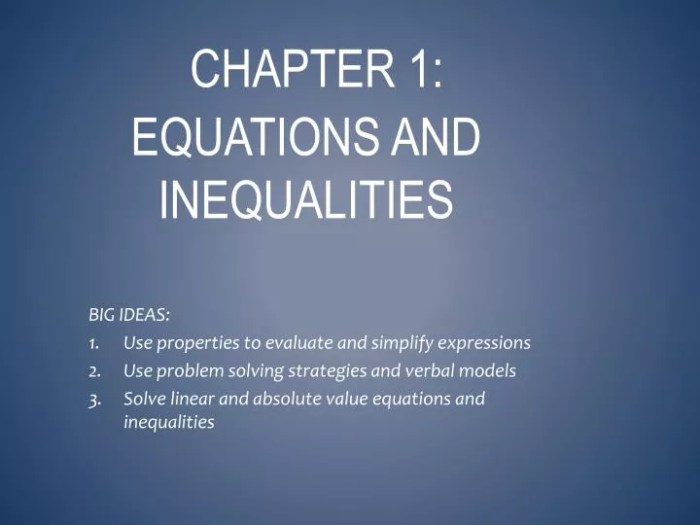Embark on a journey through the realm of mathematics with our comprehensive Chapter 1 Equations and Inequalities Answer Key. Delve into the intricacies of algebraic equations and inequalities, mastering their properties and unlocking their applications in various fields.
This guide provides a thorough understanding of solving equations, isolating variables, and graphing inequality solutions. Discover the nuances of compound inequalities and the significance of checking solutions to ensure accuracy.
Equations and Inequalities in Chapter 1: Chapter 1 Equations And Inequalities Answer Key

Equations and inequalities are fundamental mathematical concepts that form the foundation for solving problems and modeling real-world scenarios. They are widely used in various fields, including science, engineering, and economics.
Types of Equations and Inequalities
- Linear equations: Equations of the form ax + b = c, where a, b, and c are constants and x is the variable.
- Quadratic equations: Equations of the form ax^2 + bx + c = 0, where a, b, and c are constants and x is the variable.
- Inequalities: Mathematical expressions that compare two values, such as x > y or x ≤ y, where x and y are variables or constants.
Properties of Equations and Inequalities, Chapter 1 equations and inequalities answer key
Equations and inequalities possess certain properties that govern their behavior:
- Symmetry: If (a, b) is a solution to an equation or inequality, then (b, a) is also a solution.
- Transitivity: If a = b and b = c, then a = c.
- Distributive property: a(b + c) = ab + ac.
- Associative property: (a + b) + c = a + (b + c) and (a – b) – c = a – (b – c).
Solving Equations
Solving equations involves isolating the variable on one side of the equation. This can be achieved through various methods:
- Substitution: Replacing the variable with a known value to simplify the equation.
- Elimination: Adding or subtracting the same quantity from both sides of the equation to eliminate a variable.
- Factoring: Decomposing an equation into factors to simplify it.
Solving Inequalities
Solving inequalities follows a similar process to solving equations, but with additional considerations:
- Graphing: Plotting the inequality on a number line to visualize the solution set.
- Testing points: Substituting values into the inequality to determine if they satisfy the condition.
- Compound inequalities: Combining multiple inequalities using conjunctions (and) or disjunctions (or).
Applications of Equations and Inequalities
Equations and inequalities have wide-ranging applications in various fields:
- Science: Modeling physical phenomena, such as motion and thermodynamics.
- Engineering: Designing structures, circuits, and systems.
- Finance: Calculating interest rates, loan payments, and investment returns.
Advanced Topics
More advanced topics in equations and inequalities include:
- Systems of equations: Solving multiple equations simultaneously.
- Absolute value equations: Equations involving absolute values.
- Quadratic equations: Solving equations of the form ax^2 + bx + c = 0.
Commonly Asked Questions
What is the difference between an equation and an inequality?
An equation establishes equality between two expressions, while an inequality compares two expressions and indicates whether one is greater than, less than, or not equal to the other.
How do I solve an equation?
To solve an equation, isolate the variable on one side of the equation by performing inverse operations on both sides.
What is the concept of compound inequalities?
Compound inequalities involve two or more inequalities joined by “and” or “or.” The solution set includes values that satisfy all or some of the inequalities, depending on the conjunction used.